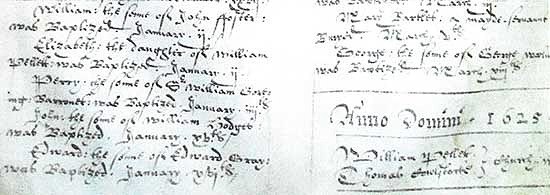
Museum archives: Our Parish Registers in the 17th Century
The baptisms, burials and marriages of the people of Steyning are recorded in the Parish Registers. Apart from the facts they record, they can also tell us something about the times people were living in and about the vicars who made the entries in the book.Two very different vicars ‘bookended’ 17th century Steyning. Between 1605 and 1630 it was Jonas Michael who cared for the souls of Steyning people. His writing in the registers is unmatched for its quality and clarity and his humanity shines through his entries. He did not just note the name and date of a burial as the other 17th century vicars did. He adds comments about the people who had died. So there were, for example, 'Ellys Rider: an aged impotent man', 'Mary Ashfould: a young mayden', and 'John Mollens: a poore travaley'. Other entries reflect the hazards of life. There was 'Richard Gregory: a young man slayne' and 'William Clemens: found drowned was buryed May 13 1625'. He reserved his gentlest entry, however, for his mother 'Anne Michael; widdowe: a virtuous and godly matrone: dyeing ould and full of days'.
At the other end of the century was Joseph Prowd. Of all the vicars who kept the registers none did it so badly as he did. Occasionally he made only one entry a year. Moreover, when he tried to recover some unpaid 'Vicaridge Tythes' in a 1691 court case, we discover that the tithes were not paid to the vicar because he had been suspended from his office for a full year. The contemporary view of this vicar can be gauged by the fact that, on his death in 1701, a memorandum debating who should be his successor notes 'That upon ye decease of Mr. Joseph Prowd aforesaid (who enjoyed ye Vicaridge of Steyning by usurpation) . . .' Strangely the only tablet (or hatchment) commemorating a seventeenth century Steyning vicar, which can be seen on the walls of the Church today, is for this particularly unsatisfactory incumbent.
On occasions the registers reveal how hard times affected the community. After a disastrously bad harvest in 1637 the privations were great. At Steyning, In the following February, 'there was only one sack [of corn] in two market days . . . nor would the farmers sell any to the poor'. Pestilence followed the famine. In the preceding years the average number of burials recorded in Steyning’s parish registers was twenty-three each year – but between 1838 and 1841 the number leapt up to an average of thirty-eight. Amongst the 152 who died in those years was the vicar’s own son, the vicar at that time being Leonard Stalman (1630-1643), 'James Tyday, a Souldier', 'Nevell Hearsi, a musitioner' and no fewer than five of the household of John Parson, the brewer.
Between 1653 and 1658 something strange appears in the registers. In under six years one hundred and one marriages are referred to – at a time when the population of Steyning can have been no more than 500 at most and maybe as few as 300. The reason for this apparently inexplicable record lies in the fact that, with the disturbances of the civil war, many clergy had been removed from their benefices and the government had stepped in to make other arrangements for the due recording of marriages. It became a requirement for banns to be read out in a market place, in parishes where no accredited vicar existed, and for a Justice of the Peace to record the event. As Steyning was the principal market place in this part of Sussex, where there were also Justices available, many couples came to the town from quite distant parishes.
It is impossible to do justice to all the stories lying behind the entries in the Parish Registers. But even this quick foray offers a flavour of the life of Steyning people in the 17th century and tempts you to ask what more they can reveal.

